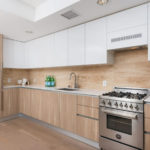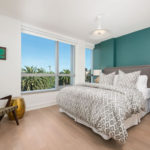Purchased for $773,000 or roughly $1,066 per square foot in March of 2014, the “ultra modern” one-bedroom plus den unit #309 at 8 Buchanan Street (a.k.a. Linea) returned to the market priced at $898,000 or roughly $1,239 per square foot last year, a sale at which would have represented total appreciation of 16.2 percent or 8 percent per year.
Withdrawn from the market and newly listed for $799,000 last month, the sale of 8 Buchanan Street #309 has closed escrow with a $775,000 contract price or roughly $1,069 per square foot and total appreciation of 0.3 percent over the past three years, but likely with a little up and down between.
And for those doing the math, the 725-square-foot unit’s HOA dues are $509 per month, not including $300 per month for the parking space with which it was listed which is leased in the building’s garage.








Some evidence of flatness rather than up-and-down in between: 2125 Bryant St # 308. Sold 2/23/2015 for $1,700,000. Resold 6/15/2017 for $1,720,000.
That’s assuming, of course, that the market didn’t move up from the first quarter of 2014 to the first quarter of 2015, nor from the first quarter of 2015 to the end of that year.
And those are two assumptions which are hard to support based on any trend data, be it new condo pricing (which peaked in the third quarter of 2015), the Case-Shiller index for “San Francisco” condos (which peaked the second quarter of 2016), or even median price trends in San Francisco proper (the moving average for which peaked in the second quarter of 2016 as well).
All these apples to apples need to figure in the loan and closing costs upon acquisition and agent commissions upon selling plus transfer tax etc. On these high value homes that is big money lost.
Why? Isn’t the point (of fruit/fruit comparisons) to track underlying price trends, not to determine w/not it’s a good investment? Unless of course the price builds in the fringe costs, and even then only if they change radically would it distort the base price.
Lots of people track underlying price trends in order to make investment decisions, not just for sport. Transaction costs are a big part of real estate that you need to figure in. In short, if you sell for the same price you bought, you lost.
I’m not disputing that, I’m just saying the problem is w/ how people use the metric, not the metric itself. And to perhaps anticipate your next point: even if you have a gain – net of all costs – you still may have “lost,” compared to other alternatives.
By my calculation, the purchaser’s nut before mortgage interest deduction is about $4800 per month assuming a 20% down payment, RET, Insurance, Common Charges, and Parking. So he/she has to earn about $90K per year just to pay for housing in a nice, but modestly sized unit in SF.
Renting is cheaper, right? This would probably rent for what – $3500 at most?
I’d estimate $4500 for rent.
It’s a one bedroom. likely not 4500.
Agreed. First number likely starts with a 3, not a 4.
No way. Rents have plateaued, if not softened – I’m not clued in to this Market/Duboce area, but there are good one-bedrooms to be had in NoPa and Inner Richmond for $2000 to $2500.
What’s a good example of a nice 1br in the inner Richmond for 2k per month?’
But you need to think about everything on an after-tax basis. The tax code was written so it hugely benefits homeowners. My wife and I earn quite a bit, and our average annual total federal and state tax rate is about 20%. So, yes, mortgage and other stuff adds up, but very little is taken out of our paychecks.
I’m not saying you are exaggerating, but I would need to see proof that you are paying about 20% in federal and state taxes if you live in CA and “earn quite a bit”.
Yea I’d love to get on the 20% bandwagon. Double professional incomes no kids usually lands you around 28 + 9 or 37% marginal rate. The deduction is on both interest and property taxes, so it’s a HUGE discount for owning vs. renting.
thats just not beleiveable. If you make a lot, you are in AMT, and being in AMT negates much of the deductions. Im paying over 40% in fed + state and certainly have a large mortgage
Do you mean 190K per year? Because after taxes, 90K per year would be about $6000 per month net? $4800 per month doesn’t leave a lot for other expenses.
Hey gang, this is the beginning…tons of future supply of for sale and rent coming on the market. This will coincide with cyclical downdraft of the economy and interest rise all of which be a downer for sales market but good for those still with paying jobs and can afford to pick up depressed units.
Yes and no. Real estate is local and, at a time when San Francisco is seeing a softening of prices and much more supply coming online in the next 2 years, prices should fall but how much is a guess and the drop will not be too large IMO. Making this more dicey is the historically low affordability index in SF and a potential softening of the job market here. Will tech job growth come to a standstill in SF – in favor of other cities. Additionally some large non-tech employers are pulling out – Blue Shield, Union Bank and Schwab. SS had a recent post on the drop in SF residents with jobs.
At the same time condo prices are hitting new highs in Seattle despite a massive amount of new supply coming online there in the next two years – many more units than SF will gain. That area has a more robust job situation as do many other areas such as Atlanta.
SF is likely to see a long stall in price appreciation or just a modest appreciation which tracks the national average instead of leading it as it has been in recent years. In a decade the housing price disparity between SF and other cities like Seattle and Atlanta (both are booming metro areas) should fall significantly. This will be a good thing for SF residents as affordability should improve over the next decade..
“This will be a good thing for SF residents as affordability should improve over the next decade..”
Which residents, exactly, is housing affordability good for? Seems to me that greater affordability helps as many people as it hurts. If someone is a property owner, why on earth would they want prices to fall, or remain stagnant? I want prices to triple. People who want affordable homes can commute or live elsewhere in the country or world.
“I want prices to triple. People who want affordable homes can commute or live elsewhere in the country or world.”
Qu’ils mangent de la brioche, amirite?
You will no doubt be mystified and angered by the increasing peril of your own security as the tacit social compact and the social stabilty it imparts disintegrates, and of course, instead of laying blame at the policies that increase inequality and precarity (and your own wealth), you will surely double-down on top-down class warfare. The path of unfettered capitalism you advocate will lead to either anarchy or flat-out authoritarianism. You may be comfortable with or even desire one or both of those, but I promise that unless you yourself are one of the warlords or oligarchs, that your unearned income opportunities under either system will be sharply curtailed
The problem with that belief is affordability actually hurts more and more people as it lowers and prices “triple”. A property owner, certainly myself, would want a more sustainable and slower appreciation. If say oh, you have kids and want them to be able to afford to live here when they are adults. As a landlord I am happy with modest appreciation and a good ROI. I exchanged out of the area to another state because my belief is things can’t be sustained at the current pace in this region. And indeed that pace is slowing and job growth is faltering in SF. Do you want a close by job? Do you want your kids to have such? If so, wanting a tripling of prices is foolish. Companies are leaving SF or not adding to their SF staff because of the cost of housing. You want top notch medical services – UCSF is having a harder time attracting that kind of talent from other areas because of the cost of housing.
Be careful what you wish for.
The Tripling Economy will be Yuge, I tell you. Sign up for Another Anon University and I will show you how you can get rich while the serfs and peons who SERVICE US suck it up and commute from Manteca. Only $9999.99 per quarter of real estate genius economics and Randian philosophy!
This is an excellent and accurate assessment, in my opinion.
Affordability is a renter or home owner function, explicitly. If you’re a landlord or a commercial property owner, affordability is not the correct concept.
Wrong, because at some point high property values begin to provide negative feedback to the market.
We saw it in Tahoe during the last housing bubble, so many residents got replaced by vacation owners that the local businesses like optometrists, veterinarians, etc had to shut down. Now in SF we are seeing restaurants struggling, teachers leaving in droves, etc.
Cost of housing #1 given reason that so many people want to leave the Bay Area today (see Bay Area Council survey) and if you think there is an unlimited supply of uber rich people to replace them, you’re wrong. It’s the reason prices have already leveled off here while second tier cities continue to rise.
As a landlord I would much prefer home values to rise in a more steady and sustainable manner that these crazy booms. Which by the way, are always followed by a bust, no matter how many people think “it’s different this time” because of Facebook.
You and I are saying exactly the same thing. Affordability affects renters and owners. To the extent affordability evaporates i.e. in Tahoe, it can create a negative feedback loop. However, even a flat market increases relative affordability, offers attractive returns for capital holders (landlords) and allows business to earn returns above their cost of capital.
A reversion to the mean in SF real estate values likely, desirable and apparently under way. Finally, to compared SF to Atlanta is somewhat ludicrous. Perhaps Seattle is a better relative proxy, but even there the comparison is problematic. If the relative affordability of SF rises, say 10%, while Seattle falls 10%, you will see people returning to our fair city.
@AJ It will take lots more than a 10% move in Seattle (up) and in SF (down) to make SF’s affordability close to that of Seattle..
The median home price in Seattle is 700K w/ an 80K median income. Median home price in SF is 1.1 million w/ an 88K median income. Factor in Seattle is building 5K new units/per year at least through 2025 w/ 40% affordable and Seattle is likely to remain a more attractive city in terms of housing costs for the foreseeable future.
Seattle is aggressively addressing the affordability issue before it gets out of hand while SF never did. Even today, after Prop C, Seattle’s affordable program is stronger than that of SF and guess what – it has not deterred builders from flocking to the Puget Sound city to build. In SF we’ve been led to believe a strong affordable program will cause builders to leave. IMO that argument is a canard spun by developers.
@AJ Forgot to add that, as Washington State has no income tax, the effective median income in Seattle is probably the same as or a tad more than in SF.
There is another factor – employers. When the affordability gets so low that workers have to live a long commute away from their SF job location then there is an incentive for the employer to relocate out of SF. Hence Blue Shield is moving thousands of workers out of SF and to Oakland – the East Bay is where most of their SF workforce lives. Or Union Bank leaving partly because of the difficulty of attracting workers. Or UCSF building housing near MB because of the difficulty of attracting top talent.
Housing prices in SF are aligned more with high paying tech jobs than with the average SF job yet the tech industry makes up less than 10% of the SF workforce and may have peaked here. These prices can’t be sustained and especially given the worsening commute situation for the non-tech” SF worker who has to commute to the East Bay – as in BB and BART tube at capacity.
For all the talk of young tech workers making 6 figure salaries, most of them can’t afford to purchase a home here given the large down payment required. My LinkedIn friends are waiting/hoping for the day the SF location is relocated to the NW. – it’s likely only a matter of time. If Twitter gets bought up I’d expect those jobs will leave the city too.
It’s a perfect storm.
From your lips to God’s ears!
Or . . . this place could be a bit of an outlier. Compare 1177 California # 1511, also sold in early 2014 (for $470,000) and just sold again (for $615,000). Up 31% in that period of a little over three years. Right in line with the broader Case Shiller condo numbers, by the way (up 27%).
If anyone looking to buy in SF thinks “the market” is early 2014 prices, good luck to you!
And even better luck to those who confuse the markets for a one-bedroom in a relatively new Upper Market building, within reach of numerous other new developments, and a studio in an established building “with panoramic view[s] spanning Twin Peaks to the Pacific Ocean” and deeded parking in Nob Hill where new developments are few and far between.
Well, #306, a 1BR in this very same building, sold for $649,000 in March 2014 and again a few weeks ago for $750,000. Up 15.5%. Or #311 in the same building, sold for $677,000 in March 2014 and again a few weeks ago for $800,000. Up 18%. Both just a few points below Case Shiller’s broader measure for that time period. I suppose everything BUT this unit #309 might be an outlier. Reminds me of the old joke where a mom observed that everyone in the parade was marching out of step except her little boy.
Damn, you just cut your previous 31%, which was “Right in line with the broader Case Shiller condo numbers, by the way,” in half! But at least you’re getting a lot closer with the sale of those two slightly smaller units last month.
Now any idea on how those units were priced last year and any subsequent changes in expectations?
Okay, so we’re all in agreement that the real discussion is just the degree to which this unit #309 appears to be an outlier. May be a 31% outlier or maybe just 15-18%, or maybe 27% per CS.
that’s a lot to pay for a 1 bedroom with no parking.
And apparently no place for a real dining table.
The glut of this one particular type of housing construction (0-2 BR, low square footage) continues to baffle me. Why don’t they build the occasional 3 or 4 BR that could serve a family or a young tech worker roommate living situation?
If you’re a 24 year old who moved here to work for Uber in 2016, you’re not making a killing. It’s unlikely you’re able to live alone in comfort. Remember, a typical tech company is only ~50% engineering. The rest is HR, recruiting, finance, sales etc. Those are “I need a roommate” budgets.
Household size has been trending downwards for decades so it’s 0-2 bedroom apartments that are undersupplied the most.
Also consider the new construction premium. For the same price would you rather live in new construction with three roommates or a 100 year old flat with just one roommate? In fact, many roommate situations in older apartments are below market because the master tenant is rent controlled. Hard to compete with that.
Then there’s the logistical factor. To set up a new roommate sitch in a three bedroom you need two people with a compatible budget, neighborhood preferences and who are moving at the same time as you. That’s no simple matter and it’s reflected in the sharp dropoff in price per bedroom over 2.
there’s probably not a lot of people who’d be willing to drop over a million for a brand new shiney condo and still be relegated to living with strangers as roommates, some of whom will not maintain the new condo with the care that you would hope.
One thing about San Francisco – where else can you be a college graduate with a high paying job and still live like a college student – roommates and all.
This feels more like a one-off 2014 “overbought” case study that luckily right-sized over time – people were buying into Linea at $850-975/sqft in 2014 in the middle floors of this building (sure upper floors got to above $1K)
Keep in mind that the two smaller middle floor units referenced above were purchased from the sales office for $970 and $1,014 per square foot respectively.
I bought in Linea. I signed my contract for a 635 square foot 1 bedroom in July 2013 when they were still breaking ground. I closed in late March 2014.
My purchase price was $569,000. To unit has central air and is sound proof. If I were to sell today, I would easily get $775,000. If saybthe building has appreciated very well.
Also, 1 bedrooms get approximately $3,500 as it’s directly across the street from WholeFoods (Amazon), Safeway, a block from Church Street Muni and the tech shuttle pickup.
2 bedrooms rent for $4,500 – $5,000.